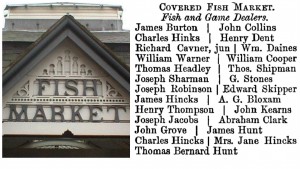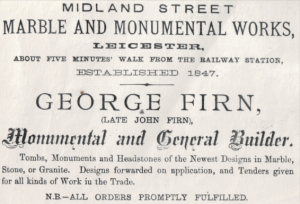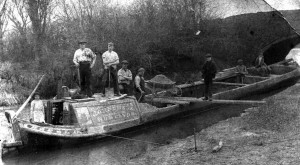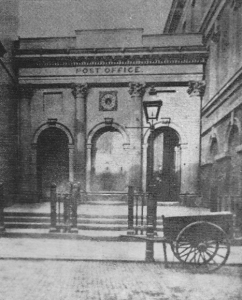As family historians, we constantly use our ancestors’ occupations as vital clues – knowing what trade a person was in can help us make positive connections with names listed in census returns, BMD certificates and parish registers. Yet often we don’t know very much about their day-to-day working lives.
How did our relatives decide which trade to pursue? What skills and tools did they use? Why did some prosper and others go bankrupt? In the Trading Stories, Working Lives series, we share some insights into occupational histories; see how we’ve enriched and broadened our research using a range of resources, then give it a go yourself.
Thomas Norman, elastic web weaver: It’s 1938 and Thomas Norman is retiring after 68 years’ service with elastic web weavers, Luke Turner & Co. Dapper and surprisingly sprightly at 82, he “can still keep pace with the average weaver” according to his boss. It’s a remarkable achievement – from loom hand to pensioner with just one firm. This article looks at the development of elastic web – used to make braids, cords, garters, corsetry, bandages, drapery, and umbrellas – and takes a walk through Turner’s factory on Henshaw Street. Click to download: Thomas Norman, elastic web weaver
John W Barker & Sons, painters and decorators: Three generations of Barkers “Opened the Way to Decorations of Distinction at Moderate Prices” and hopefully, in the process, added a dash of colour to Leicester life. This article explores the growth of a family business from modest beginnings in 1862 until its sale in 1948, illustrated with adverts from trade directories and newspapers. Nip into Barker’s shop to find a large assortment of borders, friezes, dadoes, French and English paper hangings! Click to download: John W Barker & Sons, painters and decorators
Samuel Taylor, beadle of Loughborough: Samuel Taylor would have cut a distinctive figure in the Loughborough streets – decked out in a dark blue coat trimmed with gold braid over a red waistcoat, sporting a bicorn hat worn ‘athwarts’ (side-to-side) and carrying his staff or mace. But what was involved in being the town beadle? Set aside images of serving gruel to Oliver Twist in the workhouse and instead click to download: Samuel Taylor, beadle of Loughborough
John Collins, a Victorian fishmonger and game dealer: Imagine a walk through the newly-opened Leicester fish market in 1877, surrounded by the hubbub: “A fine selection this week, ladies! Geese and turkeys, 10 pence a pound! Just look at these best English rabbits from 2 shillings apiece!” Fresh salmon, halibut, and plaice are laid out on marble slabs; there’s a smell of the seaside in land-locked Leicester. And the overhead rails are laden with pheasants, geese, rabbits and hares. Click to download: John Collins, a Victorian fishmonger and game dealer
Mary Ann Norman, laundress: Women’s employment in the past often went under-recorded. Fortunately, Mary Ann Norman’s work as a laundress merits a mention across three census returns. In this article, we roll our sleeves up and meet her at No 5 Paradise Place, getting stuck into soaking, scrubbing and ironing.
Click to download: Mary Ann Norman, Victorian laundress of Paradise Place
Joseph Taylor, lime worker: This story starts with the discovery of a rather grim gravestone inscription at Barrow Upon Soar recording two fellow workers perishing down a well:
“Two fellow workmen in this grave do lie. Both in a well at Barley Hill did die. The unwholesome damp the fatal stroke did give.”
Intrigued? Take a look at this article to see how their story unfolds against the backdrop of the Charnwood lime industry in the early nineteenth century. Click to download: Joseph Taylor, lime worker
John and George Firn, church builders and monumental masons: An enterprising father and a wayward son come together in this boom-and-bust story of church building in Victorian Leicester. Like all Trading Stories, Working Lives articles, it showcases how some resourceful searching – in this case, across the London Gazette, British Newspaper Archive, Ancestry and local history materials – can help develop a picture of our ancestors’ working lives. Click to download: John and George Firn, church builders and monumental masons
Polkey boatmen: Working as boatmen on the Loughborough Navigation was to dominate the Polkey family story for three generations. But how did it come about? This article looks at the advent of the canal in the 1790s and how it changed the Polkey’s working lives. Take a glimpse of the family living on Canal Bank, Bridge Street and Rushes; it was a close-knit, waterside community. Click to download: Polkey boatmen of Loughborough Wharf
George Robinson: Victorian letter carrier. Two records discovered on Ancestry – a British Postal Appointment book, coupled with a census return – kick-start this investigation into life as a postman in the late 1840s. It’s the early years of the Post Office, featuring many novelties – Penny Blacks, the first Christmas cards, pillar boxes and postman’s uniforms. Click to download: George Robinson the letter carrier
Three generations of Harrisons: gardeners, nurserymen and seed merchants. Starting with a mention of Harrison’s nursery on a town map of Georgian Leicester, this article digs into a range of additional sources to piece together the story of the Harrison family – including freemen’s records, a family autobiography, a bi-centenary company booklet, and books on the history of market gardening. Click to download: Harrisons the nurserymen











6 replies on “Trading Stories, Working Lives”
[…] Trading Stories, Working Lives […]
[…] In tune with Alan Bennett’s advice, we suggest you start by writing about one period or person that particularly interests you. Set aside for the time being the idea of writing a full end-to-end family history. Don’t worry that you’re not starting at the beginning of your history. Instead, just focus on one person and write about one aspect of their life. For example, you might write a brief ‘glimpse’ based about a family photo or an heirloom. Keep it short and sweet, aim for about 200 words. Then you might have a go at writing a slightly longer piece about their working life – an occupational history along the lines of our Trading Stories, Working Lives series. […]
[…] Trading Stories, Working Lives […]
[…] Trading Stories, Working Lives […]
[…] Trading Stories, Working Lives […]
[…] Trading Stories, Working Lives […]